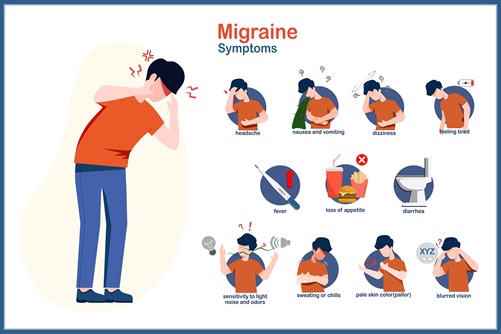
Migraine is a chronic neurological disorder that primarily occurs as moderate to severe migraine headache episodes. It affects millions worldwide, with symptoms that can significantly impact daily life. This condition is not merely a bad headache—it involves complex processes in the brain that lead to recurring attacks of migraine pain.
Migraines often follow specific patterns and can be triggered by environmental, dietary, or lifestyle factors. While there is no permanent cure for migraine, proper migraine management and targeted treatments can greatly reduce their frequency and severity.
Migraines often unfold in distinct phases, each with unique symptoms and durations. Understanding these phases can help in recognizing and managing migraine attacks effectively.
1. Prodrome Phase This early phase can start hours or even days before the headache sets in. It serves as a warning sign that a migraine is approaching. Common symptoms include:
2. Aura Phase Not everyone experiences this phase. When present, aura typically occurs 10 minutes to an hour before the headache. Symptoms may include:
Aura symptoms usually resolve within an hour.
3. Headache Phase This phase is characterized by intense pain that often starts on one side of the head but can spread. It may last from a few hours to several days. Additional symptoms can include:
Some individuals may experience a migraine without the headache, marked by other symptoms like nausea or visual disturbances.
4. Postdrome Phase The final phase, also known as the migraine hangover, can last up to a day after the headache subsides. It often leaves individuals feeling fatigued, irritable, or mentally foggy.
Migraines manifest in various forms, impacting people differently. Here are the most common types:
The most prevalent type, this form lacks the warning signs of an aura but includes moderate to severe headache pain, often with nausea and sensitivity to light and sound.
This type includes visual and sensory disturbances before the headache. Subtypes of migraine with aura are:
This rare type involves temporary vision loss or changes in one eye, often linked to a headache. These visual disturbances are usually short-lived but can be alarming and disruptive to daily activities.
Defined as headaches occurring 15 or more days a month for at least three months. The condition can severely impact a person’s quality of life, often requiring long-term management and lifestyle adjustments.
Affects individuals during the beginning of their menstrual cycle. Hormonal changes are the primary trigger, making it essential to manage symptoms with tailored treatments.
A severe complication where migraine pain and nausea persist for over 72 hours, often requiring medical intervention. This condition can be debilitating and may not respond to standard migraine treatments.
These include abdominal symptoms, vertigo, or (in children) conditions like a twisted neck. While uncommon, these syndromes can signal underlying migraine conditions needing specialized care.

Migraine symptoms vary but typically include:
Chronic migraine symptoms may occur frequently, sometimes lasting for days. Recognizing the early signs of migraine—such as mood changes, neck stiffness, or food cravings—can help with early intervention.
Causes of Migraine
The exact migraine causes are not fully understood, but they are believed to involve genetic, neurological, and environmental factors.
Key reasons for migraines include:
While the reason for migraine pain is complex, it often involves nerve signals interacting abnormally with blood vessels and brain tissues.
Diagnosis and Tests
Diagnosing migraines involves a detailed review of symptoms and medical history. A doctor may ask about the frequency, duration, and migraine headache symptoms.
Tests to rule out other conditions include:
Managing migraines involves both acute treatments for attacks and preventive measures to reduce frequency.
1. Migraine medication:
2. Migraine therapy
Treatment without medicines, such as biofeedback and cognitive behavioural therapy, can help reduce stress and manage symptoms.
3. Migraine injections
These may be used for chronic cases to prevent frequent attacks.
Those seeking migraine headache treatment at home or looking for preventive measures can try the following.
Quick Steps for Symptom Relief
Preventing migraines often involves lifestyle modifications:
For some, dietary adjustments help, especially avoiding known triggers. Supplements or medications may also be prescribed for preventive care.
Although migraines are a lifelong condition for many, proper care, awareness, and treatment can make them manageable. Early recognition of migraine symptoms and treatment options is vital to improving quality of life.
You can visit SPARSH, which is known for its advanced neurological care in Bangalore. Here, our team of expert neurologists in Bangalore will provide a personalised migraine solution, helping you live with fewer disruptions.
How to get a migraine to go away?
Rest in a dark, quiet room, apply cold compresses, and take prescribed medications for acute relief. Long-term strategies include managing triggers and preventive treatments.
Is migraine a serious problem?
While migraines are not typically life-threatening, chronic or severe cases can significantly impact mental and physical health. Consulting a doctor is recommended for proper management.
What food triggers migraines?
Common culprits include caffeine, alcohol, aged cheeses, processed meats, and artificial sweeteners. Keeping a food diary can help identify triggers.
How long can a migraine last?
Migraines can last from a few hours to several days, typically between 4 and 72 hours. Chronic migraines may occur more than 15 days a month.